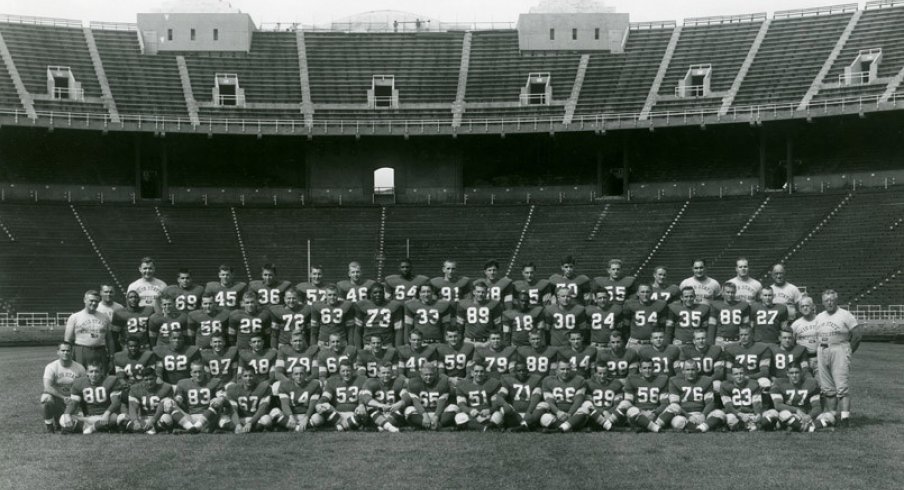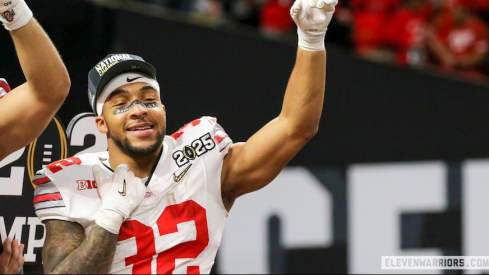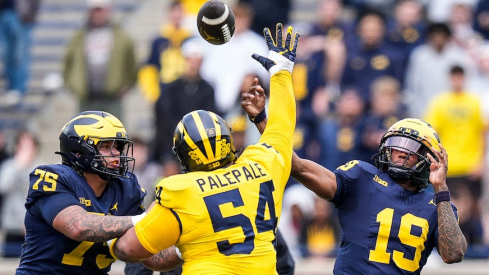A year after winning the national championship, expectations were through the roof for the 1955 season. Woody Hayes had his work cut out for him as several key players graduated.
Gone from the title team were quarterbacks John Borton and Dave Leggett. Hayes needed a capable replacement so he turned to Frank Ellwood. From Dover High School, the junior signal-caller was known for his running ability and skills running the option.
Running back Howard "Hopalong" Cassady made Ellwood's transition to starting quarterback much easier. The talented senior from Columbus Central High School was on the verge of a fantastic season.
| The 1955 Buckeyes | |
|---|---|
| Record | 7–2 |
| B1G Record | 6–0, 1st |
| Coach | Woody Hayes (5th year, 33–11–2) |
| CaptainS | Frank Machinsky and Kenneth Vargo |
Games of Note
September 24th • Nebraska • Ohio Stadium
The Cornhuskers opened the season a week earlier against Hawaii. The Rainbows – who lost to Nebraska 50-0 in 1954 – shocked the Memorial Stadium crowd and defeated the heavily favored Cornhuskers 6-0.
Using the unexpected loss as motivation, Bill Glassford's team came to Columbus more than ready. However, the Buckeyes immediately punched the Huskers in the mouth with an eight-play opening drive that ended with a Cassady touchdown.
Nebraska countered with its own score but missed its extra point. In the second, Ohio State had the ball on the Cornhuskers' 9-yard line but John Edwards changed the course of the game.
A description of Edwards' play from the Omaha World Herald:
It appeared the Bucks were sure to get the TD which might open the gates for an Ohio State romp. But the Cornhuskers, in general, and young Edwards, in particular, had other ideas.
The Husker linemen swarmed in with one Scarlet forward jolting Buckeye Frank Ellwood as the quarterback attempted a pitch-out to the speedy Cassady. The ball never found the out-stretched hands of the eager Hopalong.
Nebraska Linebacker Edwards, moving through a yawning hole in the Ohio line, grabbed the ball and headed goalward.
From the press box he appeared to grab the ball out of the hands of the befuddled Ellwood. Players, however, said in the Husker dressing room that it was an interception.
Johnny started from the 10. He was 20 yards in front before the Buckeyes started a futile chase.
The Edwards score put the Huskers ahead, 12-7. Don Erway's placement conversion shoved the margin to 13-7.
The Buckeyes did not trail for long as Cassady found the end zone a second time. His 10-yard touchdown run gave Ohio State a 14-13 halftime lead.
In the third quarter, the Cornhuskers clawed back. With the Buckeyes' defense shutting down the run, Nebraska turned to the air. Facing a fourth down, Erway heaved the ball toward the end zone and found end John McWilliams for a score. The Huskers took the lead again, 20-14.
Ohio State then took over. Cassady and Ellwood each scored in a span of six minutes and put the game away. Hopalong finished with 170 yards rushing and three scores, which put him ahead of Chic Harley on Ohio State's career touchdown list.
Glassford, a Lancaster native, retired at the end of the season and did not get another shot at the Buckeyes. He is still alive and resides in Scottsdale Arizona. At 102 years old, Glassford is the NFL's oldest living player.
| DATE | OPPONENT | LOCATION | RESULT |
|---|---|---|---|
| SEP. 24 | NEBRASKA | OHIO STADIUM | W, 28–20 |
| OCT. 1 | STANFORD | STANFORD STADIUM | L, 0–6 |
| OCT. 8 | ILLINOIS | OHIO STADIUM | W, 27–12 |
| OCT. 15 | NO. 11 DUKE | OHIO STADIUM | L, 14–20 |
| OCT. 22 | NO. 15 WISCONSIN | CAMP RANDALL | W, 26–16 |
| OCT. 29 | NORTHWESTERN | OHIO STADIUM | W, 49–10 |
| NOV. 5 | INDIANA | OHIO STADIUM | W, 20–13 |
| NOV. 12 | NO. 20 IOWA | OHIO STADIUM | W, 20–10 |
| NOV. 19 | NO. 6 MICHIGAN | MICHIGAN STADIUM | W, 17–0 |
| 7–2, 201–97 |
October 1st • Stanford • Stanford Stadium
No. 8 Ohio State traveled to Palo Alto owning an 11-game winning streak. Stanford (1–1) entered off a shutout loss at Oregon State.
This matchup marked the first meeting between the Buckeyes and Indians, the first time since 1890 that Ohio State started its season against two opponents it had never played before.
Chuck Taylor's game plan was to limit Cassady. The Stanford head coach relied on future College Football Hall of Fame defensive lineman Paul Wiggins to plug holes in the trenches and the strategy worked. Hopalong finished the game with 37 yards on 11 carries.
The Indians scored on the opening drive of the game and eventually won 6-0. The outcome left Hayes dismayed about his offense and its ability to score.
October 15th • #11 Duke • Ohio Stadium
The loss to Stanford knocked the Buckeyes out of the AP Poll. The following week Ohio State found its offense and defeated Illinois 27-12. Cassady rushed for 95 yards and two touchdowns.
Ohio State returned to the AP Poll before it hosted No. 11 Duke. The Blue Devils (3–0) entered the game following a Week 2 shutout win over Tennessee. Its three wins came by a combined score of 101-14.
Bill Murray's Duke team took a page from Stanford and focused its defensive efforts on stopping Cassady. It worked again, and the Ohio State star ended the afternoon with just 40 yards on 11 carries. The Buckeyes' passing game also struggled, only completing two passes for 27 yards.
Coverage of the 20-14 loss from The Chicago Tribune:
After the Buckeyes roared away to a 14 to 0 lead against the Blue Devils they suddenly were overcome by an acute attack of Northern hospitality. The result was a 20 to 14 triumph for Duke.
[...]
The Buckeyes, who bore little resemblance to a team defending its national title, made only eight first down to 20 for Duke. They also were outgained 218 yards to 138 on the ground and 123 to 27 by air, as the Blue Devils, in one stretch completed nine straight passes to take the lead.
The home loss left Ohio State at a disappointing 2–2.
| OPPONENT | STREAK | RECORD |
|---|---|---|
| NEBRASKA | W1 | 1–0 |
| STANFORD | L1 | 0–1 |
| ILLINOIS | W2 | 26–16–3 |
| DUKE | L1 | 0–1 |
| WISCONSIN | W4 | 16–6–3 |
| NORTHWESTERN | W7 | 23–9–1 |
| INDIANA | W4 | 24–10–3 |
| IOWA | W2 | 10–6–2 |
| MICHIGAN | W2 | 15–33–4 |
October 22nd • #15 Wisconsin • Camp Randall
The night before the battle with the Badgers, Hayes received tragic news. Former All-Big Ten tackle, Dick Hilinski, died in a car accident 15 miles north of Ann Arbor. A member of Hayes' 1954 championship team, Hilinski was helping the coaching staff in 1955. However, a wedding in Fenton, Michigan, had him away from his team the weekend of his death.
Hayes shared these words about Hilinski with the Milwaukee Sentinel: "He was just about the most brilliant boy I ever knew...it was a terrible shock, as great an offensive tackle as we ever had."
No. 15 Wisconsin and its then-record 53,529 welcomed the Buckeyes to Camp Randall Stadium and the Badgers led 14-0 early, leading those on hand to believe Ivy Williamson could get his first win against Ohio State.
But that dream did not come to fruition as the Buckeyes scored the game's final 26 points. Elwood scored three times and Cassady rushed for 100 yards and a touchdown and Ohio State left Madison with a 26-14 victory.
Williamson retired at the end of the season and finished his career 0–6–1 against Ohio State.
November 12th • #20 Iowa • Ohio Stadium
Following the win against the Badgers, Ohio State took care of Northwestern and Indiana by a score of 69-23. Against the Wildcats, Cassady tied Red Grange's Big Ten career touchdown record of 31 and broke the next week with two touchdowns against Indiana.
The Buckeyes faced Iowa in the home finale. Thirteen seniors took the field for a final time looking to lead Ohio State to its 12th straight Big Ten victory. Iowa played inspired football, but Cassady proved to be too much.
The senior ended the day with a season-high 169 yards and three touchdowns. The 18 points pushed Cassady past Chic Harley on Ohio State's all-time scoring list.
Ken Vargo secured the 20-10 victory when he intercepted an Iowa pass with just over 7 minutes remaining. Now 6–2, Ohio State remained undefeated in Big Ten play with a trip to Ann Arbor on tap.
November 19 • #6 Michigan • Michigan Stadium
Hayes used the passing game to his advantage in season's past. However, No. 9 Ohio State did not attempt a single pass in its victories against Indiana and Iowa. With a Big Ten title on the line, would Ohio State's head coach put the ball in the air again?
Just like for the Buckeyes, The Game also had Big Ten title implications for No. 6 Michigan. A victory would give the Wolverines their first championship in five years and send them to the Rose Bowl. A loss would send Michigan State to Pasadena.
A record crowd of 97,369 showed to watch the Buckeyes' defense completely dominate the contest. Michigan only snapped the ball one time in Ohio State territory. The Wolverines lost yards on that play and never crossed the 50 again. In its program's 600th football game, Michigan was outgained 337 to 109 in total yards.
Don Vivic and Cassady tallied touchdowns in Ohio State's 17-0 victory which gave the Buckeyes a school record 13th consecutive conference win.
The Wolverines did not take kindly to the loss and started to play dirty. A recount of their unsportsmanlike play as described by the Cleveland Plain Dealer:
The violent warfare reached its climax late in the last period, when three successive penalties on Michigan for personal fouls and unsportsmanlike conduct landed the ball 18 inches from the Wolverine goal.
From that point, Vicic plunged for Ohio's second touchdown, at 13:44 of the fourth quarter.
More penalties filled the tumultuous closing minute, with fans crowding the sidelines and trying to rip down the goal posts before the game was over.
This was Ohio State's first victory over Michigan in the Michigan Stadium since 1937, in the era of Francis Schmidt 18 years ago -- and its fifth all time in the huge bowl opened in 1927.
Cassady finished his final collegiate game with 146 yards and a touchdown. Hayes only called three passes in the game and the Buckeyes completed one for four yards.
In December 1955, Howard "Hopalong" Cassady won the Heisman Trophy. He finished his career as Ohio State's all-time leader in career rushing yards, all-purpose yards, and points scored.
Three Buckeyes – Les Horvath, Vic Janowicz and Cassady – won the Heisman Trophy between 1944 and 1955.
1955 Recap
- For the first time since 1890, Ohio State opened the season against consecutive first-time opponents.
- The Buckeyes defeated Nebraska 28-20 in the first meeting between the schools.
- Stanford stopped Cassady and the Buckeyes in a shocking 6-0 victory.
- Ohio State defeated Illinois and increased its series lead to 26–16–3.
- No. 11 Duke defeated Ohio State 20-14 in the Horseshoe.
- Wisconsin's coach Ivy Williamson finished his career without a win against the Buckeyes.
- Ohio State did not attempt a pass in victories over Indiana and Iowa.
- The Buckeyes defeated Michigan for the first time since 1937 in Ann Arbor. Ohio State improved to 15–33–4 in the series.
- Ohio State finished the season with 13 consecutive Big Ten victories and its second straight Big Ten title.
- Howard Cassady became Ohio State's third Heisman Trophy winner.
- Ohio State finished the 1955 season ranked No. 5 in the AP Poll.
- Cassady and Jim Parker were named All-Americans. It was Cassady's second All-American honor.
-
Hopalong Cassady, Fran Machinsky, Ken Vargo and Jerry Harkrader were selected in the NFL Draft.
In 1955, fans wanted a repeat national championship, but the first win over Michigan in Ann Arbor since 1937 and 13 straight conference victories served as worthy prizes.
This marked the first time since the days of Chic Harley that Ohio State won consecutive Big Ten titles. But the "no repeat" rule prevented the Buckeyes from playing in the Rose Bowl.
Throughout the season, Hayes called attention to the lack of student-athlete scholarships offered in the Big Ten. Other conferences awarded money to student-athletes, but the Big Ten did not back then. With Hayes as the driving force, the Big Ten adopted a complicated financial need program to allow athletic scholarships.



